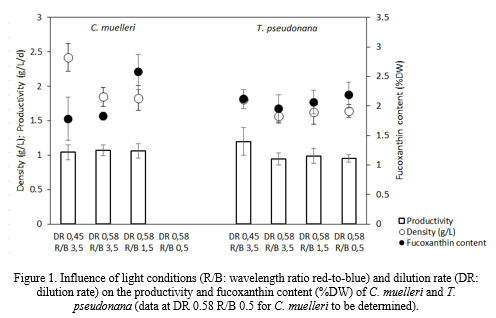OPTIMIZATION OF PRODUCTIVITY, FATTY ACID AND FUCOXANTHIN CONTENT OF Chaetoceros muelleri AND Thalassiosira pseudonana IN THE PROVIAPT FLAT-PANEL PHOTOBIOREACTOR
Introduction
The production of microalgae with a stable and high nutritional quality within hatcheries and nurseries of crustaceans and bivalves is still a major bottleneck. Culture conditions are often suboptimal, reducing culture density, productivity and resulting in lower and unstable nutritional microalgae quality. Furthermore, contamination often spoils the product and culture crashes reduce hatchery yields, all increasing the operational costs. F inally, regular photobioreactors are often unsuitable for the cultivation of sensitive microalgae species such as Chaetoceros sp., because of induced shear stress, again resulting in low productivities and a reduced nutritional quality.
Proviron (Hemiksem, Belgium) has developed, engineered and patented a closed photobioreactor system for indoor cultivation of microalgae, named ProviAPT (Proviron Advanced Photobioreactor Technology), which is particularly suited for the mass production of high quality algae biomass for aquaculture purposes. One ProviAPT production reactor features a total of 35 vertical flat panels and a volume of 220 Liters , made out of a feed-grade plastic film material, illuminated artificially by means of LED lights. The vertical stacked reactor configuration allows high areal productivities and the specific reactor geometry allows operation both at low pressure gradients and at reduced airflows. Other than resulting in major cuts in energy cost for aeration, this geometry provides gentle cultivation conditions allowing the system to host sensitive, recalcitrant species. Rigorous control and standardization of the operational parameters results in a product of constant and high quality.
The presented work includes: (1) the optimization of productivity, lipid content, fatty acid profile and fucoxanthin (bioactive carotenoid) content in a lab-scale proviAPT reactor by means of light conditions (wavelength mixing ratios) and dilution rate; and (2) the validation of these laboratory scale observations at full production scale.
Materials and methods
Chaetoceros muelleri (CCAP 1010/3) and Thalassiosira pseudonana (CCAP 1 085/12), two diatoms with importance in larval feeds , were cultivated in 6.4 Liter lab-scale ProviAPT photobioreactors in semi-continuous operation mode, with a feed cycle of 12 hours. A temperature of 20.5 ± 1°C, CO2 concentration of 0.5 %(v/v) and a salinity of 25 ppm was applied, while light intensity was kept at 473 µmol photons/m²/s in a 20:4h day-night regime. Tested operational conditions are presented in figure 1. Temperature, pH, salinity and cell density were logged daily. After a minimum of 7 days in equilibrium conditions, microalgae biomass was harvested and stored at - 20°C upon freeze-drying and analysis for ash fraction, total lipids, fatty acid profile and fucoxanthin content. Subsequently, lab-scale observations were validated at industrial scale in one reac tor battery counting 6 production units, each composed out of 16 proviAPT reactors of 220 Liter, contain ing 21 m³ of microalgae culture. Hereby, the laboratory scale ProviAPT reactor of 6.4 Liters is an exact copy of 1 of the 35 flat panels of a full-scale reactor with a volume of 220 Liters.
Results and discussion
For both, C. muelleri (CM) and T. pseudonana (TP), enriching the light in the blue spectrum over a red-to-blue ratio (R/B) from 3.5 to 0.5 or increasing the dilution rate (DR) from 0.45 to 0.58 , did not influence the average growth rate significantly with a value of 1.06 ± 0.02 g/L/d for CM, compared to 1.02 ± 0.12 g/L/d for TP (Figure 1). In contrast, for CM , fucoxanthin content increased significantly with 44% (from 1.8 ± 0.4 to 2.6 ± 0.3 %DW) when the light was enriched with blue wavelengths ( R/B from 3.5 to 1.5) . Fucoxanthin content of TP was not influenced by the color of light, presenting a stable value of 2.1 ± 0.1 %DW. An increase in dilution rate, resulting in a decrease in biomass density, was not observed to influence fucoxanthin content.
Enriching the light in the blue spectrum ( from a red-to-blue ratio of 3.5 to 1.5) resulted in an increase in total fatty acid content from 55 to 68 mg FAME/g AFDW for TP , with a significant increase in eicosapentaenoic acid (EPA; C20:5n-3) from 1.3 to 2.0%AFDW. Similarly, docosahexaenoic acid (DHA; C22:6n-3) increased from 0.19 to 0.27%AFDW.
The full fatty acid profile and total lipid content for both microalgae species will also be presented, as well as the validation of laboratory scale observations in production scale proviAPT photobioreactors.
Conclusion
The presented findings indicate that light conditions ( e.g. decreasing the mixing ratio red-to-blue) can be tuned at industrial scale microalgae production facilities to incre ase the fatty acid, EPA and DHA content of the diatom T. pseudonana and fucoxanthin content, a promising bioactive compound in larval feeds, of C. muelleri. Furthermore, the suitability of the proviAPT lab oratory scale photobioreactor was verified to maintain a constant microalgae productivity with a stable nutritional value over time under fixed operational conditions, while it was found that optimized growth conditions at laboratory scale can be applied at industrial scale.
Acknowledgements
This study is part of the BlueMarine³.Com project funded by the Flemish government through Flanders Innovation and Entrepreneurship (VLAIO) and is facilitated by the Blue Cluster program.
